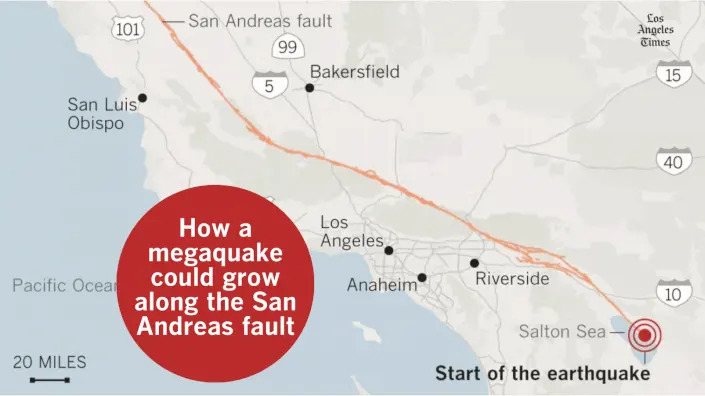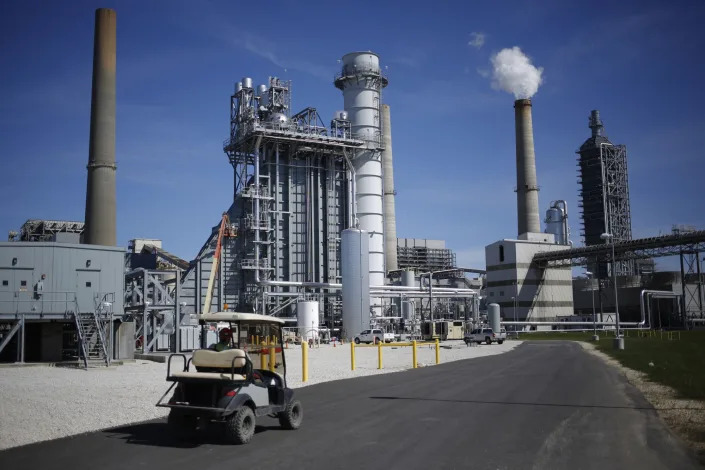Rong-Gong Lin II
Wed, February 8, 2023
The mega-quakes in Turkey this week showcase how a magnitude 7.8 quake could trigger a magnitude 7.5 aftershock on a different fault, with 60 miles of distance between the epicenters.
A similar seismic scenario could occur in California.
Mega-quakes that could rupture the southern San Andreas fault from near the Mexican border through Los Angeles County and beyond could trigger major aftershocks and shake cities as far away as Sacramento and San Francisco, according to documents and interviews.
In a U.S. Geological Survey report published in 2008 detailing a hypothetical magnitude 7.8 earthquake in Southern California, scientists said a plausible aftershock scenario included a magnitude 6.95 quake that would shake Sacramento and Modesto three days after the mainshock, endangering the stability of the levees, which are crucial for maintaining flood control and water movement from the northern Sierra Nevada to cities across the state.
Distant sizable aftershocks have occurred in California before.
The great 1906 earthquake, best known for destroying much of San Francisco, also triggered quakes much farther away on the same day, said seismologist Lucy Jones, a research associate at Caltech. They included a magnitude 5.5 in Santa Monica Bay and a magnitude 6 in the Imperial Valley, near the Mexican border, Jones said.
Supersized earthquakes are more likely to cause supersized aftershocks — and they can happen much farther away than more modest quakes.
For instance, the great 1906 earthquake ruptured a vast swath of the northern San Andreas fault, from Humboldt County near Eureka, through the San Francisco Bay Area and approaching San Benito County, east of Monterey.
The length of the ruptured fault — nearly 300 miles — is important.
Earthquake scientists say that a subsequent quake that is generated "one ruptured fault length" away from the mainshock can be considered an aftershock.
That means the Santa Monica Bay quake, roughly 250 miles from the southernmost end of the ruptured San Andreas fault, would be considered an aftershock of the 1906 San Francisco quake.
In addition, subsequent earthquakes a distance of roughly four times that of the ruptured fault length of the mainshock are considered "triggered" quakes.
So the fault length that ruptured in the Turkey quake — about 125 to 185 miles long — would produce a higher chance of follow-up earthquakes as far as 620 miles from the mainshock fault's ruptured length, according to Jones.
"So out to something like 1,000 kilometers [620 miles], we have an increased chance of having earthquakes," Jones said. "We aren't going to see it everywhere 1,000 kilometers away, but we're going to see it."
It's therefore plausible that a magnitude 8.2 earthquake on the southern San Andreas fault, rupturing from near the Mexican border, through Los Angeles County and ending in Monterey County, could result in a subsequent earthquake in San Francisco, Jones said.

A plausible magnitude 8.2 earthquake on the San Andreas fault involves the rupture of more than 300 miles of fault, from the Mexican border through Los Angeles County to Monterey County. (Angelica Quintero and Maneeza Iqbal / Los Angeles Times)
"If we get the bigger rupture, and it extends north to Parkfield [in Monterey County] — then all of the Bay Area's within one fault length," Jones said.
Simulations of huge quakes in California show how aftershocks can occur far from the mainshock. Large aftershocks can occur for months, years and even decades in a broad region, with a mega-quake potentially ushering in a generation of heightened seismic activity.
Another plausible scenario: A magnitude 7.8 earthquake on the southern San Andreas fault, rupturing near the Mexican border to Lake Hughes near Santa Clarita spurs a magnitude 7.2 aftershock on the Cucamonga fault, rupturing between the Cajon Pass and Monrovia.
"This event would cause substantial further damage throughout the San Gabriel Valley, perhaps increasing the financial losses and deaths by 20% to 30%," the U.S. Geological Survey said in the 2008 report.
A magnitude 7.71 aftershock could affect communities such as Palm Springs, Palm Desert, Rancho Mirage, Coachella, Thermal, Mecca, Imperial Valley, Brawley and El Centro. Significant damage could extend to San Diego and Imperial counties.
And a magnitude 7 earthquake rupturing 52 miles of the Hayward fault east of San Francisco could produce significant, damaging aftershocks farther away from the hardest shaken areas beneath Oakland, Berkeley, Hayward and Fremont. One scenario includes a magnitude 6.4 earthquake in Cupertino, in the heart of Silicon Valley, more than five months after the mainshock, a USGS report said.
This story originally appeared in Los Angeles Times.












